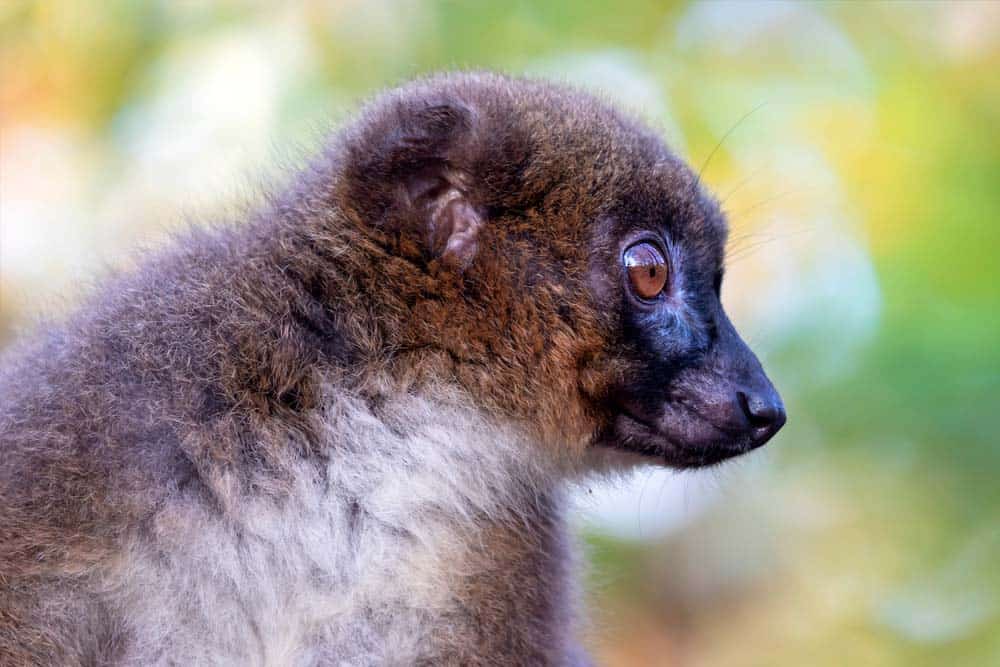Lemurs are endemic to the island of Madagascar and are comprised of roughly 100 different species. Lemurs typically sleep in trees and nests, but some sleep in caves or on the ground. Primates do not generally hibernate, but one lemur species is the only primate in the world that goes into hibernation. Besides these curious facts, most people also want answers to the question, “are lemurs nocturnal or diurnal”? Here, we explore the sleep behavior of these animals and discuss whether lemurs are nocturnal or diurnal.
Sleep Behavior Varies Across Species

Lemurs are endemic to Madagascar and have different sleep behaviors across species, including nocturnal and diurnal.
©J.NATAYO/Shutterstock.com
Lemurs exhibit different activity patterns. Some lemurs are diurnal, some nocturnal, and some are cathemeral. Cathemeral lemurs are diurnal and nocturnal. Cathemeral lemurs exhibit a variety of activities across seasons, depending on weather and food availability. An example of a cathemeral lemur is the brown lemur. Brown lemurs are active throughout the day, depending on the weather, season, and food availability.
Diurnal lemurs are very social and live in groups known as troops. This social lifestyle ensures they can warn each other against predators. So, group sleeping behavior helps solitary lemurs stay warm and protected from predators that may hunt them while resting. However, others, such as the Sahamalaza sportive lemurs, sleep alone but use cues, like the alarm calls of birds and other lemurs, as warnings when danger or predators are nearby.
Eulemur Species Are Cathemeral, Not Nocturnal
All wild Eulemur species are considered cathemeral, but this is not true for other lemur species. Eulemur species are also called “true lemurs” A study measured five lemur species’ diurnal versus cathemeral activity by examining the ratio of daytime and nocturnal activity levels. Low daytime and night-time activity levels showed that they distributed their activity more evenly throughout the 24-hour circadian cycle.
Because of this even activity distribution, the five lemur species demonstrated cathemeral behavior rather than nocturnal or diurnal activity levels. The researchers noted the highest daytime and night-time activity levels in the ring-tailed and Coquerel’s sifaka lemurs. Also, they found that the red-ruffed and variegated black-and-white ruffed lemurs had the lowest daytime and night-time activity levels.
Some Lemurs Hibernate

Fat-tailed lemurs often stay dormant for up to seven months at a time.
©Frank Vassen from Brussels, Belgium / CC BY 2.0 – License
One type of lemur that hibernates is the fat-tailed dwarf lemur. During the dry season, the fat-tailed dwarf lemur can hibernate for up to seven months when food is scarce. Interestingly, fat-tailed dwarf lemurs enter states of REM sleep during their hibernation. REM sleep is associated with dreaming, suggesting that fat-tailed dwarf lemurs may also dream.
Their hibernation state consists of two phases: torpor and arousal. Torpor is described as a decline in metabolism, heart rate, body temperature, and activity. Their metabolic activity decreases to about 2% of its normal levels. The lemur’s body temperature, usually 98 degrees Fahrenheit, falls to an ambient temperature of 59 degrees Fahrenheit but can be as low as 41 degrees Fahrenheit.
Fat-tailed dwarf lemurs may take one breath every 21 minutes during torpor. Arousal is when the animal wakes up to eat and defecate. The fat-tailed dwarf lemur prepares for hibernation by eating as much as possible to build fat reserves, which they store in their tails. Fat-tailed dwarf lemurs typically spend their hibernation period inside hollowed-out logs, feeding on the fat stored in their tails.
Some Lemurs Sunbathe After Waking Up
Diurnal lemurs, like ring-tailed lemurs and black-and-white ruffed lemurs, sunbathe in the mornings. They do so to warm up before they start their daily activities, especially after cold nights. They often bask in the sun with their arms spread upright, appearing to worship the hot globe in the sky. If these lemurs were to regulate their body temperature using autonomic responses, it would take large amounts of energy and time. Consequently, lemurs that live in colder areas conserve energy by sunbathing after waking up.
Many Lemurs have Nocturnal Vision

Although many lemurs can see well during the night, they cannot see in complete darkness.
©Edwin Butter/Shutterstock.com
Many lemurs have the tapetum lucidum in their eyes. Not only do nocturnal lemurs have this feature, but some diurnal lemurs like the ring-tail, sifaka, and indris lemur do too. The tapetum glows when exposed to light. Light passes through the lemur’s retina and reflects off the tapetum. The tapetum helps lemurs see better in the dark by amplifying the light they encounter at night.
Even so, lemurs are more active at night when there is a source of illumination, such as the moon. Although lemurs have good nocturnal vision, they cannot see in entirely dark environments as they need some level of light to see. Besides, the tapetum lucidum proves that lemurs’ ancestors were nocturnal animals, which shows in many of their relatives who are currently nocturnal animals.
Where do Lemurs Sleep?
The lemurs’ sleep site affects their fitness and health. Madagascar lemurs usually sleep in trees, tree hollows, and constructed nests. Lemurs choose these sites to be safe from predators, avoid parasites, and improve their thermoregulation. Studies also show that resting in enriched sleeping areas ensures a longer, deeper sleep. Enriched sleeping areas for lemurs include features like a constructed nest, safety from predators, and optimal temperature conditions.
In contrast, lemurs who sleep in impoverished areas without these features experience shorter, poorer sleep quality. But the southern bamboo lemur in the Mandena littoral forest of southeast Madagascar doesn’t conform to this research. These lemurs have more ecological flexibility than other bamboo lemur species. The southern bamboo lemur can sleep on the ground and sometimes in the abandoned nest of a bird, the Madagascar crested ibis. Scientists assume they sleep in these bird nests or on the ground because they feed on the forest floor.
Another non-conforming lemur is the ring-tailed lemur. According to one study, ring-tailed lemurs are the only primates worldwide that sleep in the same shelter every night. Ring-tailed lemurs choose to sleep in their dens for various reasons.
The behavior of sleeping in shelters is probably necessary because it provides safety from potential predators. It also provides lemurs access to water and nutrients, regulates body temperature in cold or hot weather, and protects against deforestation. This lemur sleep pattern can also provide shelter from the intrusion of human activity. Researchers also discovered that these lemurs sleep in the same caves daily.
Nocturnal vs. Diurnal: What’s The Difference?
Navigate to Nocturnal vs. Diurnal: What’s The Difference? for further information about the nocturnal and diurnal phenomenon in various living creatures.
Up Next
- 10 Incredible Lemur Facts
- What Do Lemurs Eat? An Island Primate’s Diet
- The 14 Smallest Animals in the World
The photo featured at the top of this post is © Edwin Butter/Shutterstock.com
Sources
- Research Gate, Available here: https://www.researchgate.net/publication/259249164_Daily_Activity_and_Light_Exposure_Levels_for_Five_Species_of_Lemurs_at_the_Duke_Lemur_Center
- Nature, Available here: https://www.nature.com/articles/s41598-021-84727-3
- Research Gate, Available here: https://www.researchgate.net/publication/295077086_Behavioral_Thermoregulation_in_Lemur_catta_The_Significance_of_Sunning_and_Huddling_Behaviors
- Biodiversity, Available here: https://planet.uwc.ac.za/nisl/biodiversity/loe/page_277.htm
- National Library of Medicine, Available here: https://pubmed.ncbi.nlm.nih.gov/26860934/#:~:text=Selection%20of%20sleeping%20sites%20has,%2C%20and%2For%20constructed%20nests.
- Journal, Available here: https://www.journalmcd.com/index.php/mcd/article/view/mcd.v8i2.5
- Journals, Available here: https://journals.plos.org/plosone/article?id=10.1371/journal.pone.0253251
Thank you for reading! Have some feedback for us? Contact the AZ Animals editorial team.






